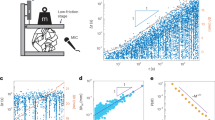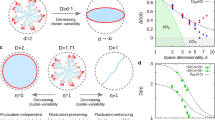Abstract
Dielectric relaxation in amorphous materials is treated in a defect-diffusion model where relaxation occurs when a mobile defect, such as a vacancy, reaches a frozen-in dipole. The random motion of the defect is assumed to be governed by a fractal time stochastic process where the mean duration between defect movements is infinite. When there are many more defects than dipoles, the Williams-Watts decaying fractional exponential relaxation law is derived. The argument of the exponential is related to the number of distinct sites visited by the random walk of the defect. For the same reaction dynamics but with more traps than walkers, an algebraically decaying relaxation is found.
Similar content being viewed by others
References
A. K. Jonscher,Nature 267:673 (1977).
K. L. Ngai,Comments Solid State Phys. 9:127 (1979).
P. Debye,Polar Molecules (Dover, New York, 1945).
G. Williams and D. C. Watts,Trans. Faraday Soc. 66:80 (1970).
Y. Ishida and K. Yamafugi,Kolloid Z. 177:7 (1961).
S. H. Glarum,J. Chem. Phys. 33:1371 (1960).
M. C. Phillips, A. J. Barlow, and J. Lamb,Proc. Soc. (London) A329:193 (1972).
P. Bordewijk,Chem. Phys. Lett. 32:592 (1975).
W. P. Helman and K. Funabashi,J. Chem. Phys. 66:5790 (1977).
W. H. Hamill and K. Funabashi,Phys. Rev. B 16:5523 (1977).
M. F. Shlesinger,J. Chem. Phys. 70:4813 (1979).
W. P. Helman and K. Funabashi,J. Chem. Phys. 71:2458 (1979).
E. W. Montroll and H. Scher,J. Stat. Phys. 9:101 (1973).
M. F. Shlesinger,J. Stat. Phys. 10:421 (1974).
H. Scher and E. W. Montroll,Phys. Rev. B 12:2455 (1975).
M. F. Shlesinger and E. W. Montroll,Proc. Natl. Acad. Sci. (USA),81:1280 (1984).
H. Scher,J. Phys. (Paris) Colloq. 42:C4–547 (1981).
B. Movaghar,J. Phys. C 13:4915 (1979).
A. Blumen, J. Klafter, and G. Zumofen,Phys. Rev. B 27:3429 (1983).
M. F. Shlesinger and B. D. Hughes,Physica A109:597 (1981).
H. Scher and M. Lax,Phys. Rev. B 7:4491 (1973).
M. Tachiya,Rad. Phys. Chem. 17:447 (1981).
E. W. Montroll and G. H. Weiss,J. Math. Phys. 6:167 (1965).
J. Klafter, private communication.
Z. Vardeny, P. O'Connor, S. Ray, and J. Tauc,Phys. Rev. Lett. 44:1267 (1980).
P. Grassberger and I. Procaccia,J. Chem. Phys. 77:6281 (1982).
R. F. Kayser and J. B. Hubbard,Phys. Rev. Lett. 51:79 (1983).
B. Ya. Balagurov and V. G. Valks,Sov. Phys. JETP 38:968 (1974).
J. Klafter, G. Zumofen, and A. Blumen,J. Phys. Lett. 45:L49 (1984).
B. D. Hughes and M. F. Shlesinger,J. Math. Phys. 23:1688 (1982).
Author information
Authors and Affiliations
Rights and permissions
About this article
Cite this article
Shlesinger, M.F. Williams-watts dielectric relaxation: A fractal time stochastic process. J Stat Phys 36, 639–648 (1984). https://doi.org/10.1007/BF01012928
Issue Date:
DOI: https://doi.org/10.1007/BF01012928




